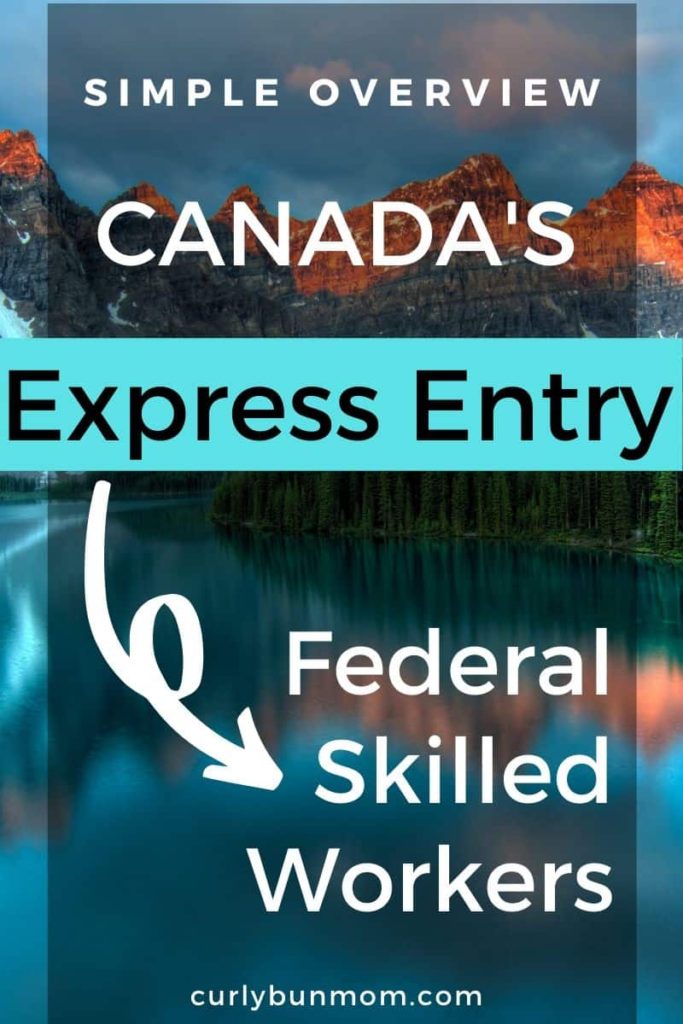Simple Overview of Canada’s Express Entry for Permanent Residence

Disclaimer: This is the process we followed and the resources we used for our application to Canada’s Express Entry System. We are not immigration lawyers and we do not represent the Canadian Government.
In my first post, I mentioned that I hoped I would get the opportunity to share a journey and I’m so excited to be able to share our experience emigrating to Canada.
We applied through Canada’s Express Entry System for Federal Skilled Workers and after just 8 months, we received our Canadian Confirmation of Permanent Residence (COPR) visa and will be landing in Canada soon.
There are various ways to get a permanent residence (PR) visa to emigrate to Canada. The first step, therefore, was to decide which route was best for our family.

Overview of Canada’s Express Entry System
Canada’s Express Entry is an online system that allows skilled workers to apply for permanent residence.
We choose skilled workers based on their skills and ability to contribute to Canada’s economy.
Express Entry manages applications for three economic immigration programs:
Federal Skilled Worker Program
Federal Skilled Trades Program
Canadian Experience Class
After reviewing the different ways, we decided to apply through the Express Entry System as Federal Skilled Workers. This DIY guide will therefore focus only on this program.
Steps and Resources for Federal Skilled Worker Express Entry
These are the steps we took and the resources we used throughout the application process:
1. NOC Code
To be eligible for Express Entry you must have previous work experience in the required National Occupation Code (NOC). Additionally, your work experience must be in Skill Type or Level 0 (managerial jobs), A (professional jobs) or B (technical jobs and skilled trades). It must also have been paid work for one (1) continuous year within the last ten (10) years for you to be eligible for this program.
Ensuring your selected NOC code is accurate is critical to approval. Some job titles and responsibilities may be difficult to match so it’s crucial to spend time properly researching.
2. Eligibility
To determine eligibility, IRCC uses a six selection factor point grid and candidates must score at least 67 out of 100 to be considered for the Federal Skilled Workers Program.
We checked our eligibility for the program by answering the online questionnaire which covers many areas including age, education, work experience, language skills, size of family and relatives in Canada.
3. Comprehensive Ranking System (CRS score)
Once you’ve passed the six selection factors and have entered the pool of eligible candidates, IRCC then ranks the applicants based on a Comprehensive Ranking System (CRS).
So, our next step was to check where we may rank, before proceeding.
4. Express Entry Rounds of Invitations
IRCC holds rounds of invitations where they invite the highest-ranking candidates to apply for permanent residence.
We decided to do some additional research by checking the current and past draws or round of invitations trend to see where we might rank in the pool of candidates.
5. Proof of Funds
IRCC requires each applicant to have a specified amount of funds to settle in Canda as a newcomer.
To meet this requirement we got our bankers to prepare proof of funds documents and we ensured that we had sufficient funds for the various fees (IELTS, WES, Medical exam, Police Certificates, and permanent residence fees).
6. Language Skills Test
Canada has two official languages – English and French, and it is necessary to prove competence in at least one of them through an approved language test. You must score CLB 7 or above to be eligible to apply.
We decided on the International English Language Testing System (IELTS) which tests writing, reading, listening and speaking. We also perused many online resources (including youtube videos) to prepare for the test.
TIP: IELTS results are valid for up to two years, therefore it is best to schedule the IELTS exam when you know you’re in a position to start your application.
7. Educational Credential Assessment (ECA)
IRCC requires an ECA report, which confirms the Canadian equivalency for your foreign level of education. For this reason, your foreign academic qualifications must be assessed through one of the recommended organizations.
We eventually chose World Education Services (WES). The process was simple and upon completion, we received our ECA fairly quickly and with no hiccups.
8. Express Entry Profile
Once we had our IELTS results and our ECA report, we created and submitted an Express Entry profile, entered the pool of eligible candidates and waited for the rounds of invitations.
We waited 3 months before receiving an invitation to apply.
Invitation to Apply (ITA) and Electronic Application for Permanent Residency (e-APR)

After we received our invitation to apply (ITA) we proceeded with our Permanent Residence application (e-APR) through our account. We had sixty (60) days to submit our application which was sufficient to gather all the required documents.
The ITA letter provides all the necessary details and document requirements to complete your e-APR which may include:
- Medical exam by a listed physician
- Official proof of funds documents
- Police certificates
- IELTS results
- WES credentials (ECA report)
- Official academic transcripts and certificates
- Passport and travel documents
- Birth certificates
- Marriage certificates
- Official job experience letter(s)
- Letter of explanation (to explain and clarify a particular circumstance where required
IRCC also provides all the necessary guidelines for required documents (those listed above and any others that may be deemed necessary for your application).
Acknowledgment of Receipt (AOR)
IRCC sent an Acknowledgment of Receipt (AOR) after we submitted our online application. This letter confirms that IRCC has received your application and will contact you if necessary.
TIP: Ensure that IRCC emails are whitelisted because IRCC may request additional documents at any time.
Final Request for Permanent Residence Visa (PPR)
The final request email provides instructions for the next step which is getting your Permanent Residence Visa in your passport. We were required to submit our passports and photos to our local visa processing office.
Processing time for this step varies and is dependant on the visa office.
Confirmation of Permanent Residence (COPR) Visa
When IRCC processed and returned our COPR visas, they also sent a package detailing our next steps and landing information.
Overall Experience
The immigration process is definitely a lengthy and detailed one. However, it is possible to complete the process on your own as Canada has made the process as simple as possible. IRCC provides all the necessary information on their website and this accessibility ensured we had a really good and rewarding experience.
The processing time from AOR to PPR is typically six (6) months, with some applications processed in a shorter or longer time frame. Our application took four (4) months and IRCC didn’t ask for any additional documents during that time.
I hope this has been helpful and if you are going through or thinking of applying to Canada, leave me a comment below. I’d love to chat!
Also, stay tuned for our experience as we prepare to migrate, land and settle into our new home 🙂

I love Canada. All the parts I have visited are so beautiful that I could almost want to live there!
You’re right! It’s such a gorgeous place. Our kids have never been but they’re excited about all the snow and wearing jackets lol I hope they still feel the same way when we’re there in winter!
One question if I do the Express Entry, is my partner included in my process (he is not my husband, but we have been living together for 3 years)? Or should he make his own migration request?
Hi Susan, you can certainly apply together for Canada’s Express Entry Program. IRCC provides guidelines to show proof of your relationship in this link: https://www.cic.gc.ca/english/helpcentre/answer.asp?qnum=347&top=14
Hope this helps! 🙂